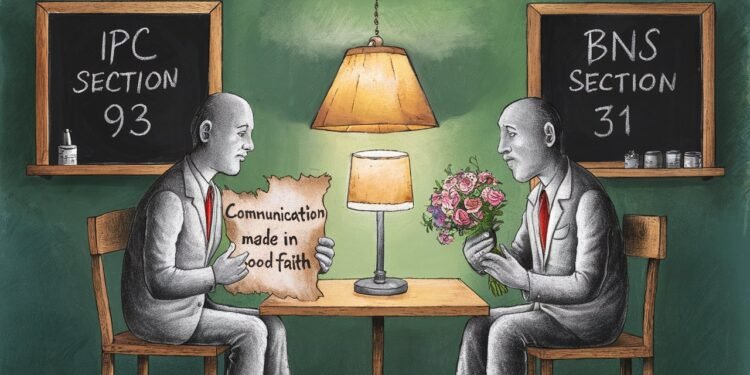Shubam Kumar Jha, 3rd year law student (BBA LLB), PES UNIVERSITY RR CAMPUS BENGALURU
Communication made in good faith (IPC section 93/ BNS section 31 )
This article explores Section 93 of the Indian Penal Code (IPC), which protects honest communication made for the recipient’s benefit, even if it causes harm. The concept of “good faith” is subjective and assessed based on context, motive, and severity of harm. Examples include doctors delivering difficult diagnoses or whistleblowers reporting wrongdoing. The article also discusses limitations, including defamation and excessively harsh language by fostering responsible communication, Section 93 plays a vital role in a society that relies on information sharing.
Introduction
The Indian Penal Code (IPC) a cornerstone of Indian criminal law outlines various offenses and their punishments. However, it also recognizes situations where actions, though potentially causing harm, may be justified. Section 93 of the IPC falls under this category, dealing with “Communication made in good faith.” This article delves into the intricacies of this section, exploring its purpose, scope, and
real-world applications
.The Essence of Section 93: Protecting Honest Communication
Section 93 states: No communication made in good faith is an offence by reason of any harm to the person to whom it is made, if it is made for the benefit of that person. In simpler terms, the section shields honest communication, even if it causes unintended harm, as long as the intent behind it is to benefit the recipient.
This section serves a crucial purpose it encourages open and honest communication, fostering trust and allowing individuals to warn others of potential dangers or offer constructive criticism. Without this protection, people might hesitate to speak up for fear of legal repercussions, hindering open discourse and potentially causing greater harm in the long run.
.Understanding Good Faith: The Core Principle
The central concept in Section 93 is “good faith.” The law doesn’t provide a precise definition, leaving it to courts to interpret based on the specific circumstances of each case. However, some key factors generally guide this interpretation:
Honesty and Belief in Truth: The communicator must genuinely believe the information they are sharing to be true. Fabrication or deliberate distortion of facts negates good faith.
Reasonable Motive: The communication’s purpose should be legitimate and aimed at benefiting the recipient. Malicious intent or a desire to cause harm would disqualify it from protection under Section93.
Responsible Manner: The communication should be delivered in a reasonable and responsible manner. Using excessively harsh language or threats would undermine the concept of good faith.
.Examples of Communication Protected Under Section 93
Doctor’s Diagnosis: A doctor, honestly believing a patient has a terminal illness, informs them of the prognosis. Though the news may cause emotional distress, the doctor’s communication is protected as it’s for the patient’s benefit, allowing them to make informed decisions regarding treatment or end-of-life care.
Warning a Friend: You witness a friend about to enter a dangerous situation. Your warning, even if it upsets them, falls under Section 93 if your motive is to protect them from harm.
Reporting a Crime: You report a suspected crime to the authorities, even if the accusation turns out to be false. As long as you reported it in good faith based on reasonable suspicion, you are protected by Section 93.
The Importance of Context in Evaluating Communication
Courts play a crucial role in evaluating communications under Section 93. They consider the surrounding context, including the relationship between the communicator and recipient, the nature of the information shared, and the manner of communication. Some factors influencing judicial interpretation include:
Severity of Harm: The potential harm caused by the communication. Minor emotional distress is unlikely to outweigh the communication’s purpose, while serious harm might negate the good faith defence.
Alternative Methods: Were there less harmful ways to achieve the same objective? For instance, could the doctor in the earlier example have broken the news to the patient in a more sensitive manner?
Case laws
Here are some relevant case laws which will help in better understanding of the provision
1. Dr. Ram Manohar Lohia vs. State of Bihar & Others (1965)
This case involved a political leader who, in a public speech, criticised the government’s handling of a food shortage. The speech caused some public unrest. Dr. Lohia argued that his communication was made in good faith to highlight a public issue and benefit the community. The court, applying Section 93 found his speech protected as it lacked malicious intent and aimed to draw attention to a critical problem.
2. Basdeo Kumar Mahto & Anr vs. State (2010)
This case involved a dispute regarding agricultural land ownership. The accused made certain statements about the ownership, which the other party claimed were defamatory. However, the court ruled that the statements were made in good faith for the protection of the accused’s own interest and fell under the ambit of Section 93 Her, the court emphasized the importance of good faith and the need for the accused to show they had reasonable grounds for believing their statements to be true.
3. Sewakram Sobhani vs. R.K. Karanjia, Chief Editor, Weekly (1968)
This case involved a businessman who sued a magazine editor for publishing an article critical of his business practices. The defense argued that the article was based on facts and published in good faith for public interest. The court, while acknowledging the public interest element, found the language used to be excessively harsh and damaging to the businessman’s reputation. This case highlights the limitation of good faith – while factual criticism might be protected, the manner of communication cannot be overly abusive.
4. State of Haryana vs. Des Raj Sangar & Anr (1975)
This case involved a land dispute where the accused approached authorities with a complaint alleging another person had encroached on their land. The complaint turned out to be false, leading to charges against the accused. However, the court, applying Section 93, ruled that the complaint was made in good faith based on the accused’s belief in their claim. This case demonstrates the protection extended to honest mistakes made with a genuine belief in the information provided.
Comparison of Interpretations and Approaches:
Courts have interpreted Section 93 in various ways, leading to nuanced approaches:
Balancing of Interests: Courts often weigh the potential harm caused by the communication against the benefit it aims to achieve. Minor emotional distress might be tolerated if the communication serves a significant purpose, while serious harm could negate the good faith defense.
Reasonable Belief vs. Absolute Truth: While absolute truthfulness is ideal, courts acknowledge the possibility of honest mistakes. Protection under Section 93 might be extended if the communicator genuinely believed the information they shared to be true, even if it later turns out to be false.
Alternative Methods: Courts may consider if less harmful methods were available to achieve the same objective. For instance, a doctor could have broken bad news to a patient in a more sensitive manner.
Practical implications and challenges
Section 93 finds application in various real-world scenarios. Here are some examples:
Whistleblowing: Employees who report wrongdoings within their organizations are often protected under Section 93, provided they act in good faith and believe the reported acts are illegal or unethical.
Journalistic Reporting: Journalists exposing wrongdoing through investigative reports might face legal challenges. Section 93 can protect them if they acted in good faith and based on reasonable verification of the information.
Social Media Communication: The explosion of social media has created new complexities.
Limitations of Section 93: When Communication Can Be an Offence
Section 93 doesn’t offer a blanket shield. Here are situations where communication, even if well-intended, might still be considered an offence:
Defamation: If the communication, though honest, damages the recipient’s reputation without a valid justification, it may constitute defamation under IPC Section 499.
False Alarms: While reporting a suspected crime is protected, knowingly providing false information or creating panic through a fabricated story can be an offence.
Excessive Language: Using excessively abusive or threatening language can negate the protection of Section 93, even if the underlying motive is good conclusion.
Fostering Open Communication with Responsibility
Section 93 of the IPC plays a vital role in Indian society. It encourages responsible and honest communication, fostering trust and allowing individuals to speak up for the benefit of others. By protecting good faith communication, even if it causes unintended harm, Section 93 empowers individuals to warn of dangers, offer constructive criticism, and expose wrongdoing. However, navigating Section 93 requires a nuanced understanding. The concept of “good faith” is subjective and open to interpretation. Courts play a crucial role in evaluating communication based on context, motive, and the severity of potential harm.
By addressing these considerations, Section 93 can continue to serve its purpose of promoting open and honest communication within a framework of accountability. In a world that increasingly relies on information sharing, Section 93 plays a critical role in balancing the freedom of expression with the need for responsible communication.
References
IPC BARE ACT 1860
https://indiankanoon.org/doc/1184400/
https://ipclaws.in/ipc/section-93/
Author also took consideration section 92 of ipc , which talks about act done in good faith ,



